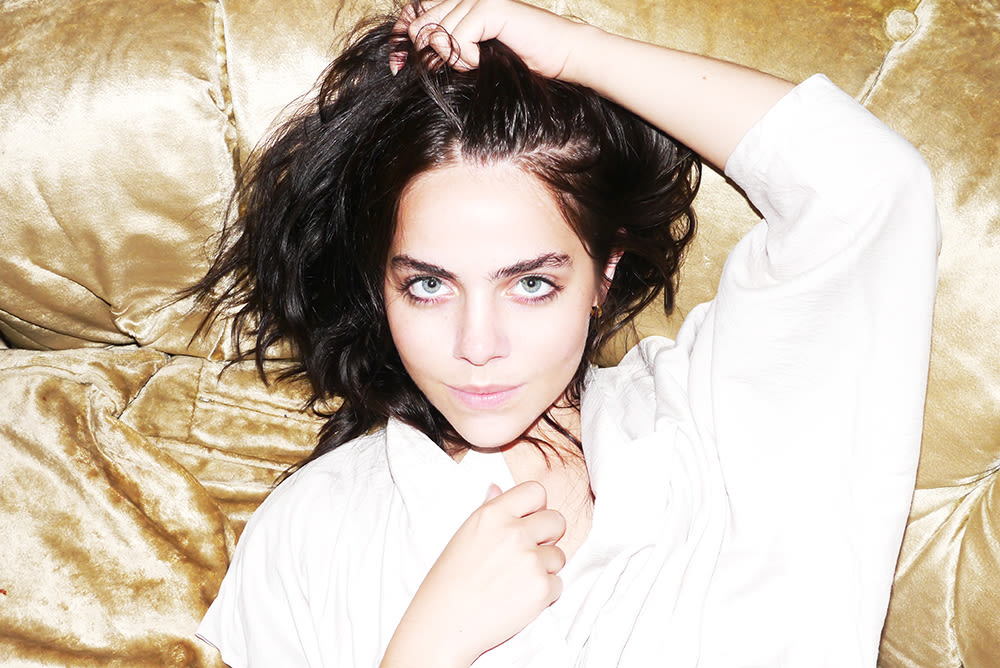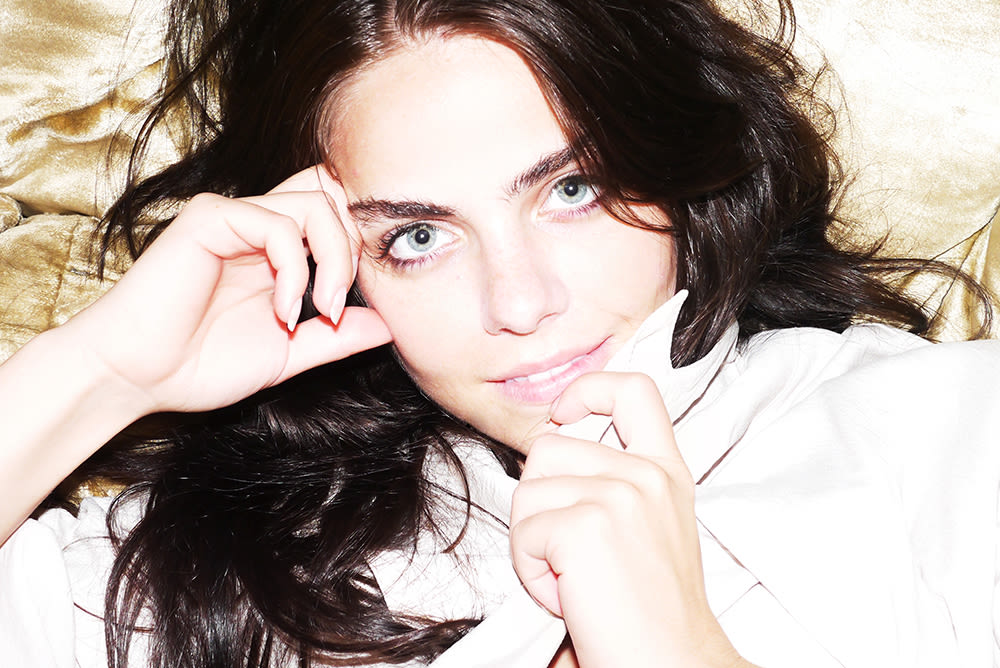A brief history of my adventures in hair color:
February 2012— Dyed my virgin-ish golden brown hair some awful shade of dark brown that glowed neon red in direct light like terriers' eyes in photos—with whatever box dye was on sale. I assumed the one box would be plenty for my waist-length hair, so the back section only got traces of color. Let it be known that no matter what color of brown the box promises—ash, chestnut, cocoa—all of it will be some variation of red. I was trying to “find myself” at the time—“myself” being a failed attempt at Adriana Lima. I attempted to shampoo her out with Color Oops, which didn't work, then went to a salon for corrective color removal, which didn't work either.
April 2012— Acceptance.I had it redone at some rockabilly hair salon in Austin, which unsurprisingly does a really great cool dark brown. That same day I also got awful bangs to balance out the nice new color. I couldn't wrap my head around the fact that I'd never have my perfectly sun-bleached natural hair ever again.
April 2013— After a year of dark brown with touchups every three months, I went back to my natural color. It took Marko at Sally Hershberger 10 hours’ worth of highlights. Promised myself I’d never dye my hair again.
November 2013— I went blonde. Marko's light touch and the modest color change that resulted confused me into thinking that bleach wasn't so bad after all. Besides, this wasn't really my natural color anyway. I had the woman known for good blonde, Aura Friedman, give me full highlights, and then another round a few days later (I have a lot of hair). The color was nearly dead on to the inspo image (Cara's ashy, yet somehow still golden blonde), but I could tell during the blowout that things would never be the same.
February 2014— Almost three inches of roots coaxed me back into a salon, where I went a bit darker—I called the shade “brown sugar” but it was more like Lipton Iced Tea. Either way, better than the blonde.
June 2014— I’m black-coffee brown once more courtesy of Saint Kimberley Pierce at Ion after a lowly #tbt reminded me of how nice it looked. Plus, filling in the microscopic bleach-burned crevices in the hair shaft with dye molecules is supposed to make hair feel and look healthier overall—I’ll take it!
So I’m realizing now that in a span of two years, I’ve had five distinct hair colors. I never thought I’d be one of those women, but here I am! Not to say that there’s anything wrong with regularly changing things up, but a woman that finds a great color and sticks with it oozes a sort of Von Teese-ian self-assuredness that I doubt I’ll ever know.
Dita’s naturally blonde. If you’ve ever clicked through one of those before-they-were-famous slideshows you’ve probably seen her high school portrait: the black mesh top, the bright-eyed smile, the enormous gold statement earring bested only by the perfectly golden side-parted swoosh growing out of her perfect teenaged head. It’s blondes like this that give rise to the dumb ones. I’ll explain.
No woman is inherently more or less intelligent based on her hair color, that’s obvious. But all the (my) blonde idols—Young Dita, Kate Moss, Monica Vitti, Brigitte, Gemma Ward, Amanda Seyfried, Anna Nicole, and most recently Anna Ewers make it look so easy, so effortless, that it turns non-blondes’ (my) naiveté dial up to 11. I thought, “I’m a smart girl. Toner, Shimmer Lights, deep conditioner, fuck chlorine—got it.” Despite all the information supporting the contrary, I figured it’d be a couple of product swaps and an extra deep conditioning treatment every week and I’d literally be golden. Dumb, you see?
I didn’t take into account that I’d essentially need to portion out around $200 every month or so for professional touch-ups. Maybe you remember the DIY Brazilian wax—I prefer to do professional-only things to myself both for my finances and because it makes me feel delightfully smug. Yet, I was too intimidated to try an at-home bleach job, so in grew the roots. And then the color—for the first three weeks it was a nice butter shade, but then things started to look plastic-y. Constantly wondering, “Is this cool blonde that I have? Or is this warm?” I tried the purple stuff, the stuff for golden blondes, everything my colorist had recommended, and every other goop marketed to blondes, but nothing seemed to make much of a difference. I wasn’t even learned enough in the blonde spectrum to know if what I had was acceptable or not.
The plastic-ness really came through in the texture. When Marko lifted me from almost black back to my natural color with a salad bowl of strategically applied bleach, he promised me that my hair’s natural body would return in a few weeks, and it did. Wavy, soft, shiny—good as new. After around 10 weeks, I came to terms with the fact that this would not be the case with the blonde. My hair was exhausted, frail, just lifelessly flopping here and there. (Reference my tiny author photo if you're curious—leave it to Emily Weiss to make deteriorating blonde hair still look OK.) It was like a burnt-out old punker getting a job at Starbucks: it had given up. At one point I envisioned myself in that fabled Tarzana, California hair salon with an electric razor going full-on Britney and starting over from scratch, awkward growth stages be damned.
Then came Kim, who took me to a warmer version of the black-coffee shade that looked too harsh in comparison to my blue eyes—a look befitting only of the singer from Evanescence. Oh, also Liberty Ross. First came a greenish base layer to correct the neglected blonde leftovers, then the glossy darkness. I was feeling pretty good, and walked back to the office that day blaring “Back in Black” as if it were the theme song to the opening credits of the rest of my awesome life.
I do want to go back to Kim, but time more than money or smugness left me with two months of light brown root growth (my hair grows remarkably fast) and a slight orangey fade. DIY ways fall hard and I soon found myself found me wielding some demi-permanent color (Wella Color Charm in Medium Ash Brown, because the online reviews promised that the color would turn out quite dark), volume 10 developer, and a set of plastic gloves. I followed directions for the most part, and ended up with the same beautiful glossy brown that she gave me the first time, which I’ve been maintaining with Aveda Black Malva Color Conditioner—a total Godsend for unnatural dark brunettes. It’s a neutral black gelatinous conditioner that I use mainly in my roots (the ends are so porous that they pick up way too much color), and is absolutely worth the slightly stained tiles and towels. Just leave in for five minutes while you shower, and rinse. I used to use the red version when I was finding myself as a second grader–and she was a child Geri Halliwell. It left a lovely, and quite potent red tint that washed out after two or three showers.
Though with the enormous amount of room for error with DIY dye jobs—especially on previously color-treated hair like mine, I can't in good faith recommend that anyone reading should dye their's at home, as it's what sparked my 2.5 years of hair color struggles. I imagine if not for that first carefree go at boxed color, I'd have spent the beginning chunk of my twenties mastering ukulele or some other highly marketable skill. Instead I studied blogs and beauty forums, product labels, Yelp reviews... Which is why I type this, in hopes that another young girl chasing dreams of Adriana Lima through Google search “best home hair dye' will gain some clarity on hair color: see a professional or don't do it at all. Go nuts with that Aveda stuff, though. Really, it's good.
—Annie Kreighbaum
Photos by Brayden Olson.






